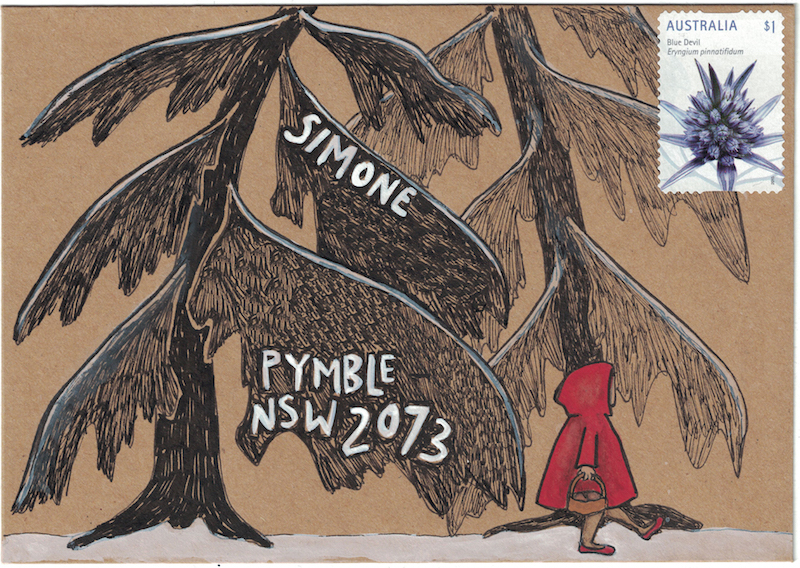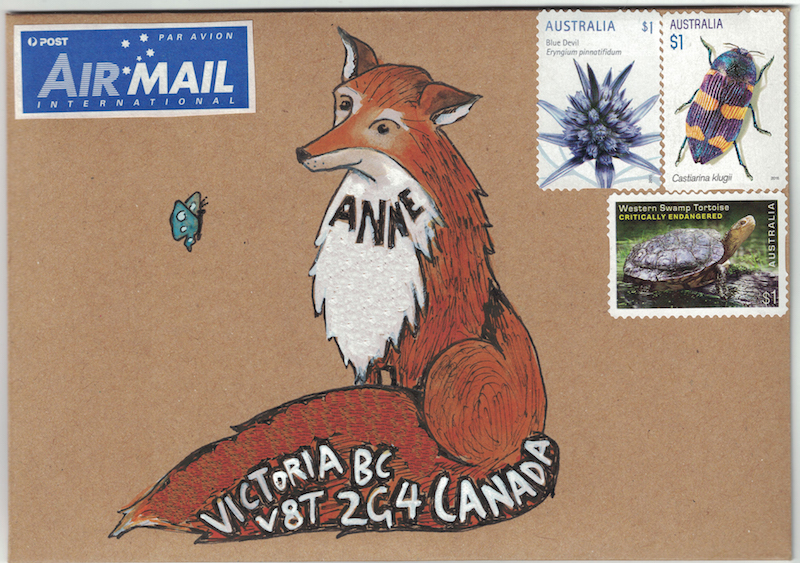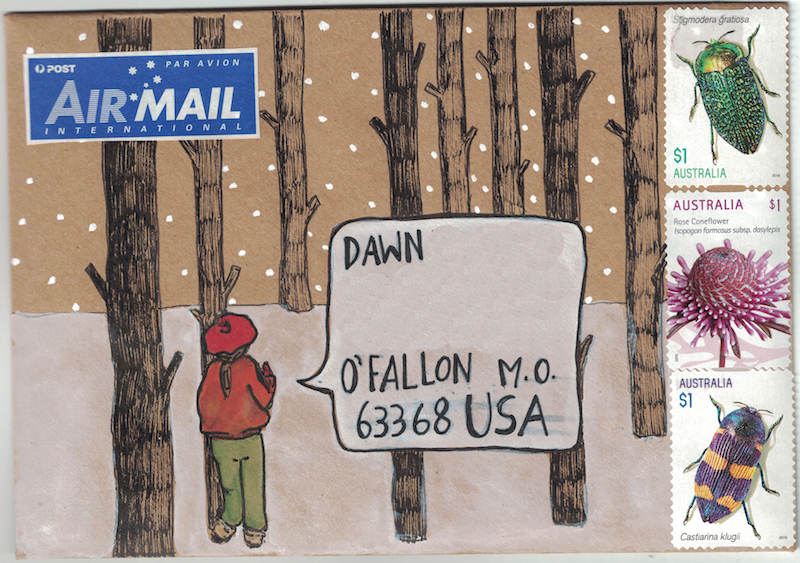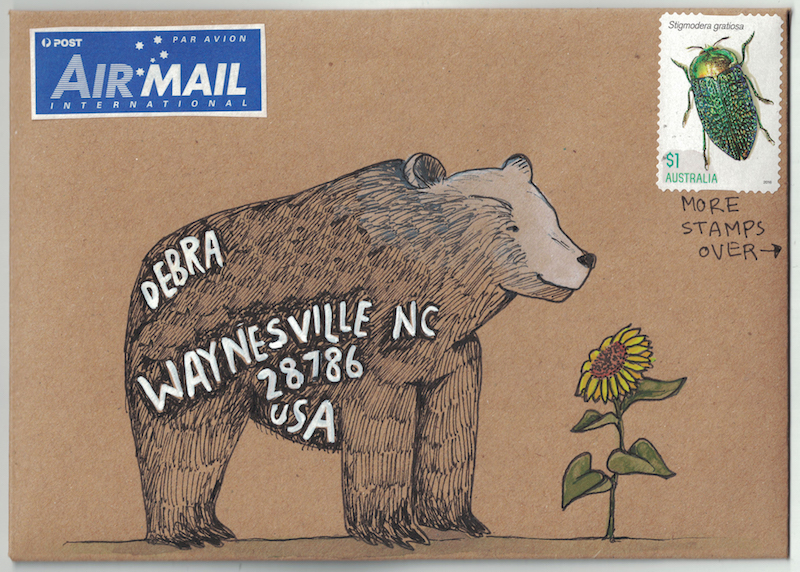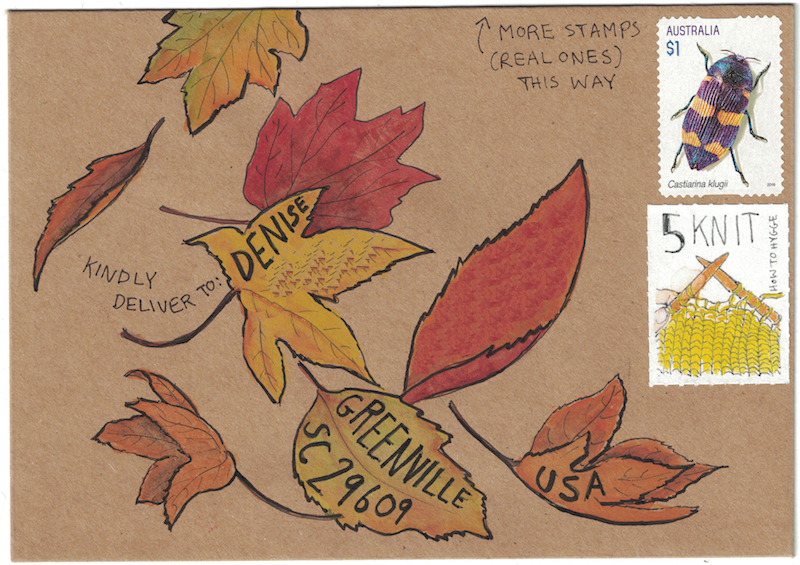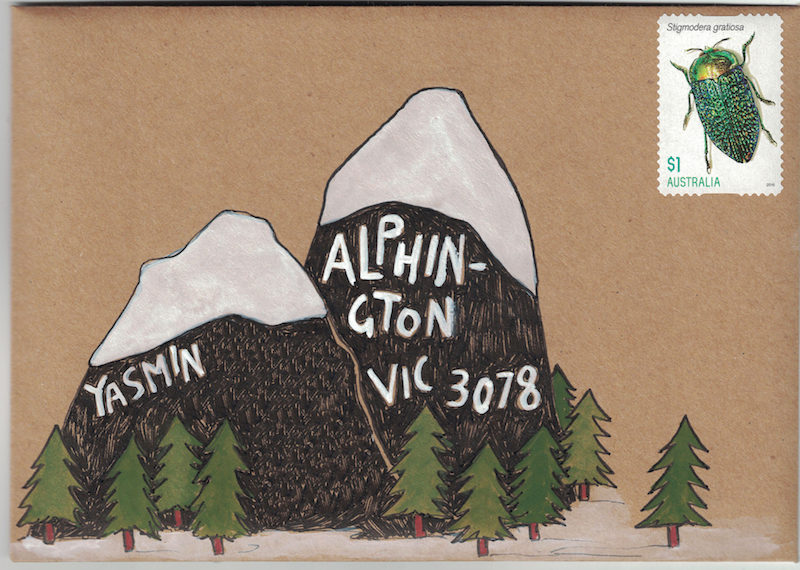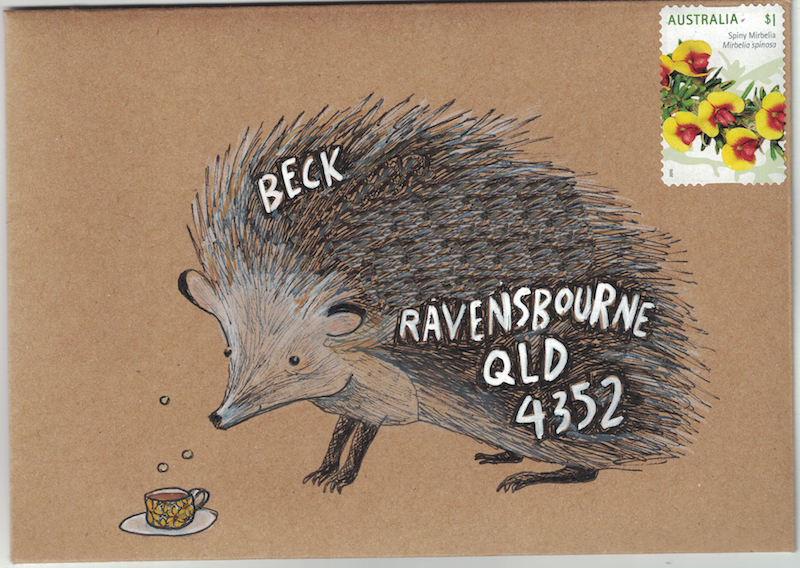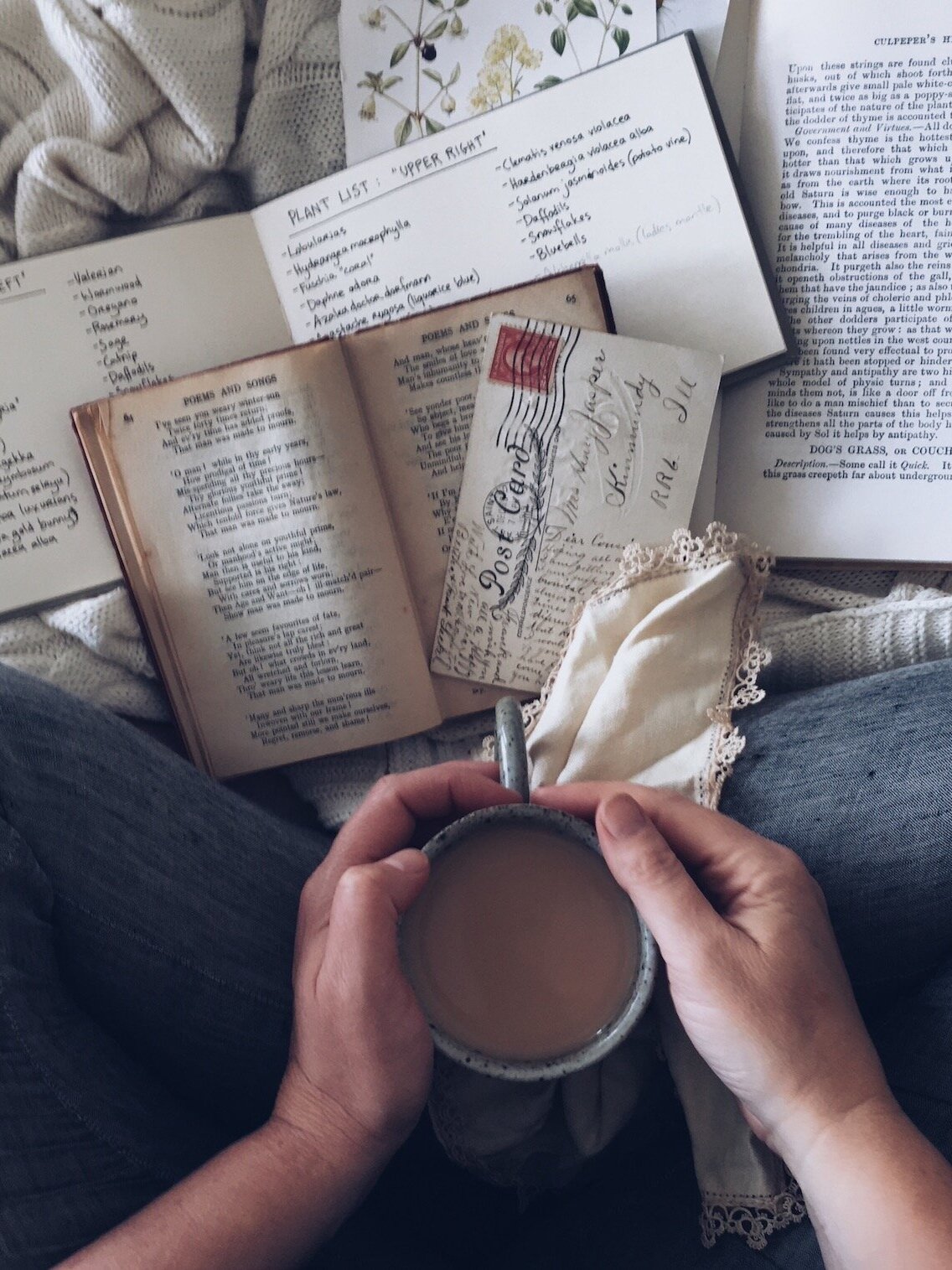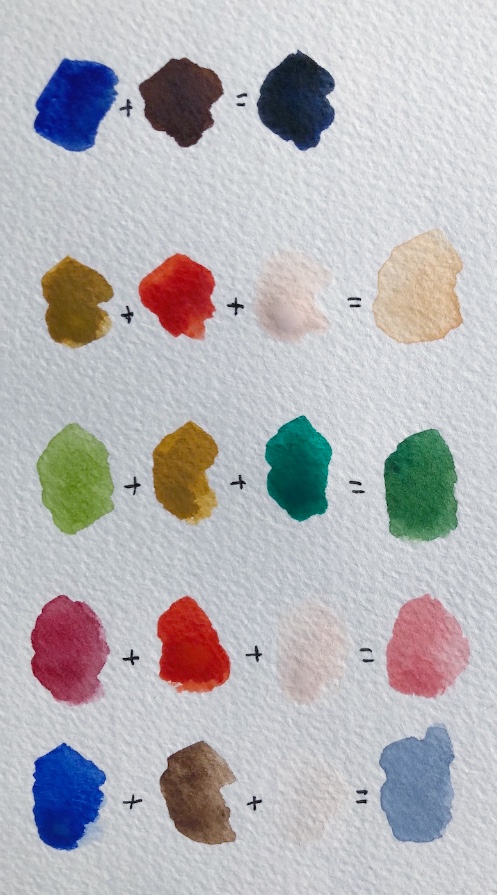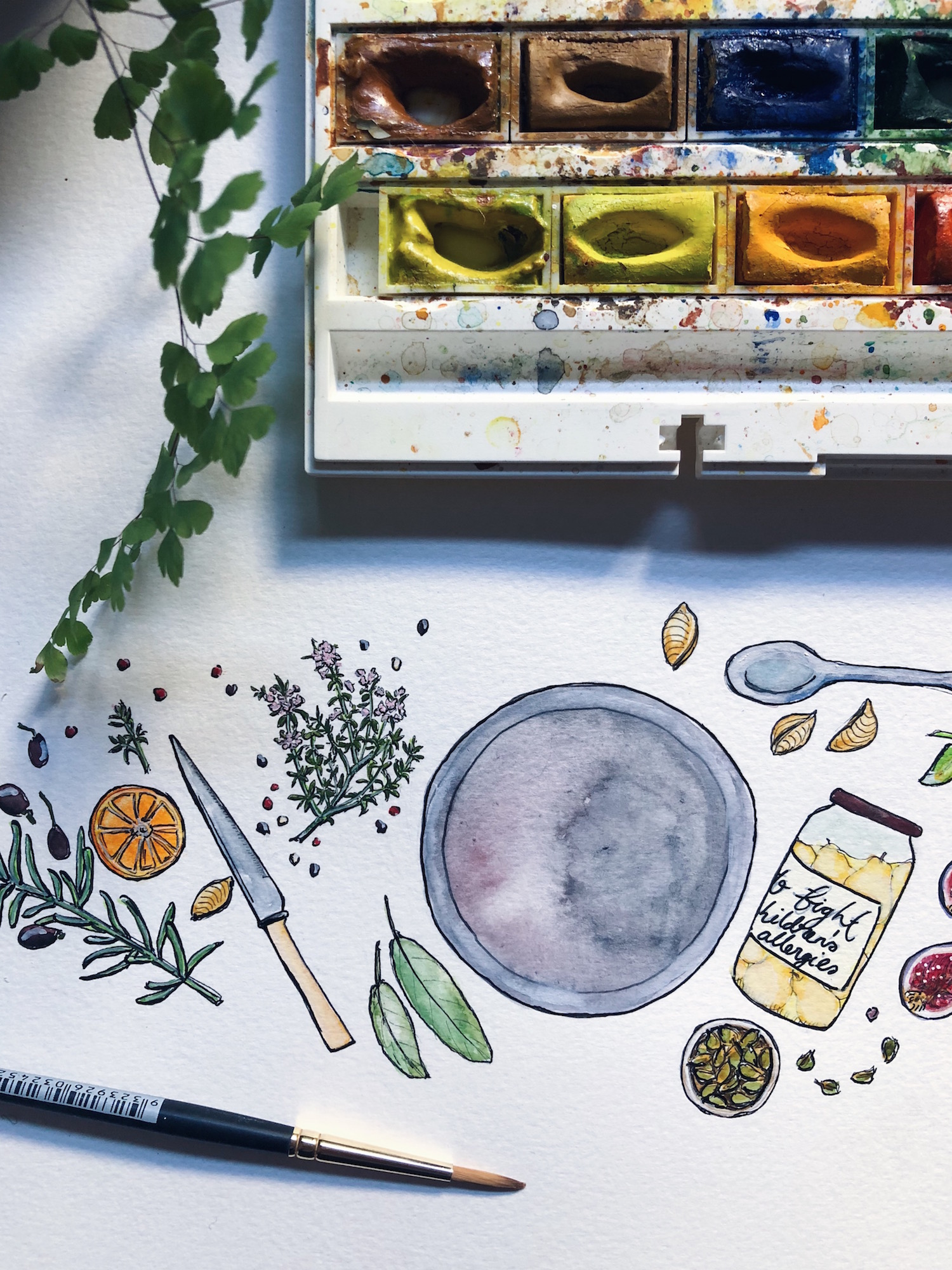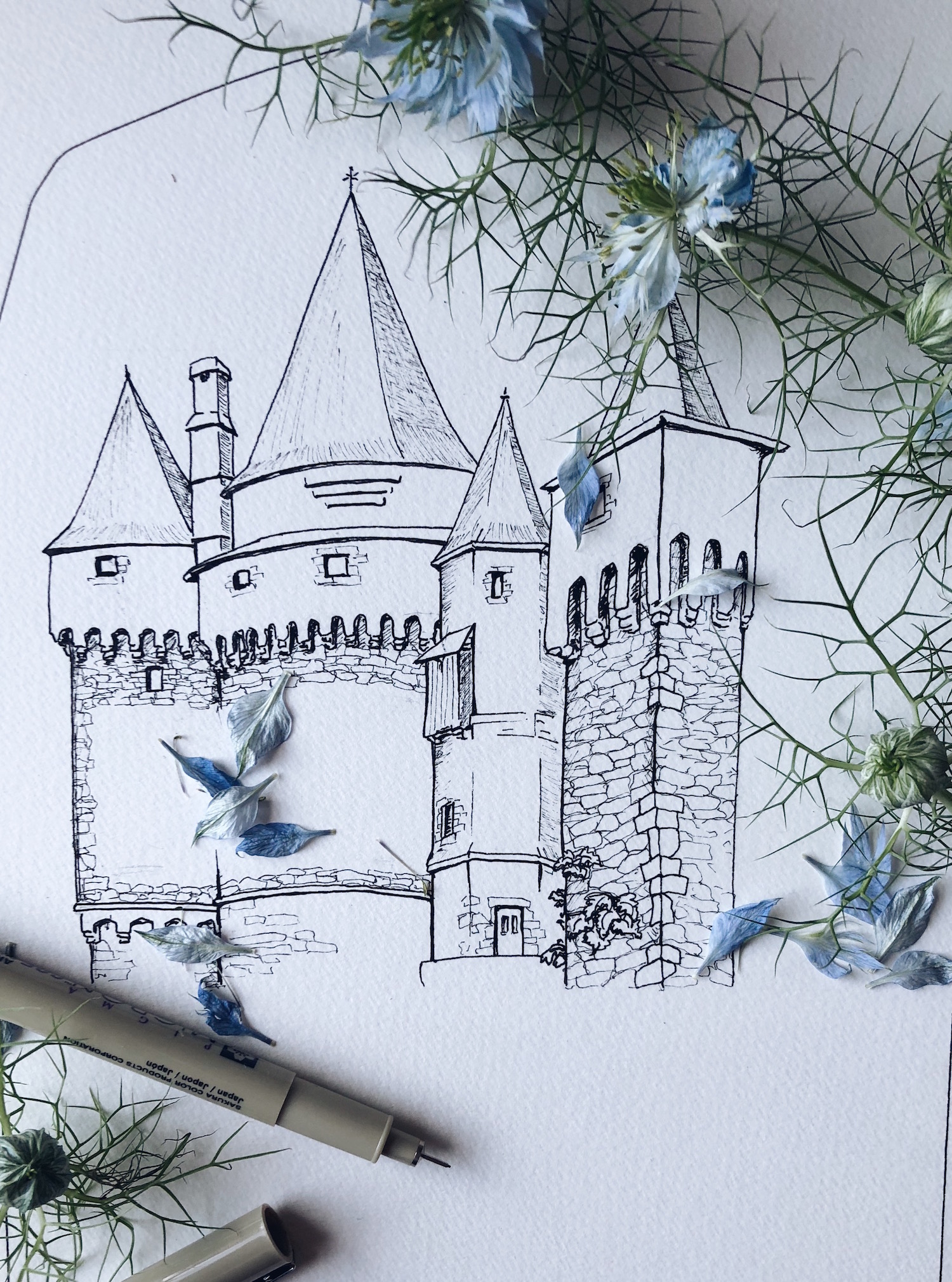
JOURNAL
documenting
&
discovering joyful things
Christmas in a time of Covid
After one of the most difficult years most of us can remember, I think we could all do with a little moment to stop and celebrate, don’t you? This online magazine - a bumper version of my monthly newsletter - contains ideas for celebrating and sharing the joys of Christmas, even if you are in lockdown; mindful gift ideas and DIY projects; tips for writing Christmas letters; 12 festive envelope templates for you to colour in and post; and loads more.
Flip through the magazine below (if you hover over the magazine window you’ll see an option to make it full screen), or click “download” to print and read it the old-fashioned way, and to use any of the resources and templates inside. (Give it time if it’s slow to download - it’s a big file!)
Christmas, penned and posted with love
December! This year our advent calendar is actually a book. You open the widows on the front cover, and a little picture corresponds to the relevant ‘day’ inside, where we find instructions for a new Christmassy activity each day. So far, we’ve written letters to Santa, made raspberry hot chocolate, sung Deck the Halls, and folded paper snowflakes. (I suspect the children would still have preferred one of those calendars with tiny chocolates inside each window, but the book-calendar has me feeling altogether festive).
On Saturday we wandered into the city together as a family, and Christmas still seemed suitably far enough away that shopping felt fun, rather than stressful. (We were shopping for Ralph’s sixth birthday, which is coming up later this week, and I’ll spare you the “Where did the time go?” rant except to raise my hands towards you plaintively and plead, just once, “Where did that time go?”).
As Christmas approaches, my thinking has turned (probably not surprisingly) to letter-writing. Last week I was working on a story about snail-mail for a magazine. The editor had asked me to write about why I choose to write and decorate letters, and how I use this practise as a way to keep in touch with loved ones while also carving out time to practise mindfulness and indulge in creativity.
I wanted to share some personal anecdotes in the article, so I reached out to the community on Instagram and asked people to share stories about letters that had meant something special to them. The stories came flooding in, overflowing with emotion, and gratitude, and joy. I read through tale after tale of the ways in which simple words, penned and posted with love, became treasured and cherished keepsakes.
Truly, these stories warmed my heart. And I wondered, not for the first time, why we spend so much time combing the shops for gifts that are all-too-often at best unneeded and at worst also unwanted, when we could better spend that time writing a thoughtful, heartfelt letter. A letter that - unlike soap-on-a-rope or novelty socks - will most likely be kept for a lifetime. And sometimes longer.
In my letter-writing e-course, I share a photograph of a postcard in my possession that was written by my great-uncle Bert to his sister, my great-grandmother, from a training camp in Egypt during the First World War. You can see the ink thinning, and then the point at which he must have dipped his pen back into the ink-bottle to continue, and it gets darker again. The signature, "Brother Bert" and a kiss, is squeezed onto the bottom, and there are ink blotches where rain might have fallen on the card.
Blue lines cover some of his words: redactions from censors, presumably to stop Uncle Bert from accidentally revealing secrets. I never knew my great-uncle, but his postcard keeps him alive. I feel connected to him through his handwriting on this postcard, an up-and-down cursive that is eerily similar to my mother's.
I like to think of all the handwritten postcards like this one, and the letters, Christmas cards, invitations and love-notes, penned by hand throughout the ages.
What if we were to replace some of our gifts with heartfelt thoughts? Telling our loved ones that we truly do love them.. telling them why we love them… and sharing little stories about them that hold special meaning to us. We could decorate our envelopes before we post them, drawing pictures or colouring patterns to give them some extra festive flair. Or we could press leaves and flowers in between the folds as tiny treasures, tie each letter up in a giant, oversized ribbon, and set them under the tree to be handed to our loved-ones in person on Christmas morning.
I didn’t end up using the stories that everyone had shared, for my magazine article. But they are just too good to slip into obscurity and so I thought I’d publish them here, instead. I wonder if, after reading them, you will be feeling as inspired as I am to pick up a pen!
“The year before my grandmother turned 90, I started writing her a weekly letter as a secret birthday present to her. My then 7-year-old daughter would decorate the envelope with drawings from her imagination of my grandmother traveling to a new exotic place or having a unique new job. My grandmother was absolutely delighted seeing herself as a coal miner, a rollercoaster designer, or exploring the pyramids in Egypt. About halfway through the year my grandmother caught on and started to send us a weekly letter in return. She will turn 94 this March and something that I originally intended as a gift for her has truly become a gift for all of us.” @gracefulheart
“I have all the letters my dad has written me. He wrote one about the day I was born, telling the events of that day and how I came into the world. He wrote me letters of encouragement as I struggled through university. He wrote funny ‘news articles’ about events happening back home when I was working a summer job at a camp. We haven’t always had the easiest of relationships, but his letters are one of my most cherished possessions since they offer a glimpse of how much he really loves me.” @lauradipoeti
”Last year I was given a super precious gift of a couple of years’ worth of letters I had written to a friend...so many memories I had forgotten.” @allyt_hobart
”I'd have to attrubute my love of mail to my nanna. We lived in a different state to her growing up and she was very deaf. I remember my parents encouraging me to write her letters. As a kid they were not very interesting...results of netball games. A summary of birthday presents. Years later when I was going through her things after she passed away I found every letter her grandchildren ever wrote to her. Some read so many times the paper was worn. To her a letter was the voice of her grandkids she couldn't hear. For get eulogy i wrote her a letter as a way of saying goodbye her way.” @onething_atatime
“My husband used to write me love letters when he was working away in the middle of the desert and in them would be desert flowers. I will keep them forever.” @rachgilmore79
“I have a tin full of the letters my father sent to his family during the WWII. It includes his 21st birthday cards that were sent to him in the Middle East when he was serving, as well as the black edged telegram his mother received to tell her that he was MIA presumed a German POW. It also includes his invitation to his own wedding, because in those days it was ‘the done thing’. I also have a collection of letters between my father and myself. We were living in PNG at the time and I was sent home to live with family to do Grade 6 here in Australia before I headed to high school.” @illawarra_cottage_and_garden
”My mother-in-law and I wrote letters back and forth. When she died unexpectedly I was able to give my husband the letters she had written.” @tallmadgepamela
”A friend of mine kept getting visits from a beautiful neighbourhood cat that really brightened her day and entertained her kids so she wrote a little note to tell the owners how much they were loving the cats visits and attached it to the collar of the cat for the owner to find.” @secretlifeofemmy
“Looking through some old papers at my mom’s house a couple of years ago, I found an old letter to me from my grandfather. He had written it just before my wedding and it was full of well wishes for a happy life. My mother had saved it and I had tears in my eyes reading it. He passed in 2001 and the letter was written in 1995.” @maria_at_the_lake
“I traveled to Australia before my senior year of Highschool and my father & I wrote letters while I was away. He passed away suddenly in October of my Senior year. I went back to Australia after graduation and there, waiting for me at my old Aus post address, was one last letter from my dear ol dad.” @tisha.cullen76
“I have a friend. We met at the summer camp by the sea in the Poland 35 years ago. For me it was first time by the sea (I am from Czech republic) Three amazing weeks full of new adventures and new friends! That time the letters were only way how to stay in touch. And we keep writing. It is beautiful friendship.” @ jolana_sekyrka
”At a house clearance in the 80's my Auntie bought an unopened trunk. Inside was a love story between a woman and her lover during World War 1. From the beginning of their courtship all the way through to the telegram she received telling her he had been killed on the frontline. There were photos and ration books and notes of wedding plans. It was an entire love story.” @samburgessuk
“I corresponded with an older lady I met on a cruise when I was 25, she was single and lived in Canada. We write regularly until she passed away, when our children were young and a letter arrived from Rita we would sit in our good room and read it. I loved that she was a part of their childhood. She lived a very interesting life and I have one of her paintings in my daughter’s old bedroom.” @chrissystant
“I went to college out of state so during the school year I received letter from my friends at home and during the summers I received letters from all of my college friends. We all sent them on papers from our workplaces, mainly to be funny, but now they are so telling: greasy menu papers from a fish camp, daily schedules from a childrens camp and order forms from a shop. Those letters are so silly and carefree, I would love to go back to those days.” @lrc100
“A few years back while clearing out my grandparents' house we found a letter from my grandma to my grandad written just after she'd had my dad, describing dad as a rather fat baby. I've always had penpals but writing to my grandma was extra special - I'll always remember how she wrote 'to-day' and 'to-morrow' in the old fashioned way.” @tomatopincushion
“Being a former military member,and wife, letters were our only life line as we moved all the time. I've managed to keep a few letters from those years. We wrote pages at times. Everything stopped when we got letters from loved ones and friends.” @pilgrimslady
“I once accidentally left a 50 page etter in the seat pocket of a Singapore Airlines airplane. The letter was to a friend in Italy, and I'd spent the whole plane journey writing it only to leave it behind in my weariness. A very kind cabin crew member must have found it and also found the address scrawled somewhere, because a few months later it turned up in Italy, much to mine and my friend's delight!” @postwhisperer
“My cousin's Grandma used to send the most incredible letters to us out here in the Middle East. Although well into her 90s and her body incapacitated, her mind was vital and lively. She was deaf but watched TV with subtitles and girls from the local school would come and visit her. She would tell me about her travels when younger and TV programmes that she enjoyed - usually about other parts of the world. She died peacefully a couple of years ago and I miss those letters.” @mycustardpie
“I found a suitcase full of letters my mum and dad wrote to each other when they were younger. It sounds silly but it's only then you realise what it was like to not have mobile phones and computers, and be in constant contact with one another. It was so lovely reading all the love and emotion on the pages in their handwriting, words that took so much more time and thought to express than the instant communication of today.” @seth.style
“My wife and I lived 5000 miles apart for the first four years of our relationship, and I sent her a different post card every single Saturday. Spent hours searching shops and ebay listings for cards I thought she’d like. She kept them all in a shoebox and brought them with her when she finally moved to the UK.” @frog.johnson
“I fell in love with my husband at first sight when I was his student. Because he was 20 years older than me, my mother just wasn’t having it. He went on sabbatical to England, and we wrote during the latter part of 1975 and all of 1976. In 1995 I finally married him. Sadly, he passed away a couple of years ago. But I still have those letters that he wrote me back in the 70s.” @therealpattietierney
“I’ve been writing to my pen friend for 48 years. All handwritten letters. She’s not family but the closest thing to it.” @glenys_learningtoweave
“When I was a kid, I found an old box of correspondence between my great-grand uncle and his family (with also mentions of my grandfather who was a young child at the time) around WW1... the letters are all written in lovely handwriting and they’ve written literally everywhere they’ve found space because they didn’t want to stop writing... lots of love letters, simple letters to know how people were doing... it’s really cool to read to have an insight of what their lives were like.” @iamcapucinne
“Before my husband and I got married we wrote letters. In total I received 72 letters. Many very long letters, like 18 pages, written on both sides. We are married 27 years now. And I’m still wondering where he got all the inspiration and courage to write so much....he’s an introvert and dyslectic.” @magicworld_illustrations
Both my parents came from very large families (18 siblings total) so I have no shortage of aunts, uncles, cousins, etc. But my family were the only ones to move far away. Letters were the way we kept in touch. I would not have the close relationship I have with my cousins now if not for the many, many letters we exchanged when we were young. And yes they are in shoeboxes still. @mariannenoepoli
“My mum died a few years ago, and occasionally finding a letter or card from her, tucked inside something, is as if she's still around.” @little_white_cloud
So now what do you think about writing a letter for Christmas? Is there someone in your life who would treasure your words, even more than a scented candle? What will you tell them?
ps. Here are some letter-writing resources I’ve made
My new Mail Art Colouring Book (vol 2) has more than 60 original mail-art envelope templates, note-paper and party invitations to colour in and post
Join me and a friendly community of letter-lovers in my five-week letter-writing and mail-art e-course: The Most Beautiful Letter You’ve Ever Written
Painting hacks (and it's ok if you're not doing it right)
Recently when I wrote my frequently asked questions post, I deliberately neglected to answer one of the questions I get asked the most often… “Can you teach me how to paint?”
The truth is that I have never felt confident enough to ‘teach’ painting, because in order to teach something it helps if you actually know what you are doing yourself! I am completely self-taught when it comes to my illustrations, and by “self taught” I mean I just keep painting, experimenting and practising… I haven’t read any books or watched any YouTube videos to improve my techniques.
(Although I’m actually hoping to remedy that this year, and take some formal lessons in botanical illustration at the Botanical Gardens in Melbourne, so maybe one day in the future I’ll have something more useful to share on here.)
But in the meantime, rather than teach you how to paint in any strict, best-practise or rules-based way, I am going to share some of the tips, tricks, hacks and techniques that I have stumbled across so far on my illustration journey.
Why it’s ok to not do it right
Because I’ve never received proper training, it is highly possible that the things I share are not the best way to do things, or that I’m simply “not doing it right.” And I think it’s important that we all seek ways to feel comfortable with this, when it comes to our own creative work.
“Not doing it right” is why I’ve held back on sharing too much in terms of how-to-paint content in the past (fear that I’m not doing it right, and fear that I’d therefore be teaching you to ALSO not do it right).
But now I’m thinking differently, and I’m going to call myself out on this defeatist attitude. Really, it’s just another form of “imposter syndrome,” the feeling most of us experience sometimes (or often) - especially when it comes to creativity - that we are not good enough, even when others appreciate our creations - and that any minute, the world will see us for the failures we secretly believe we really are.
Why do our brains do this to us?? This blog is not the place to explore the depths of human psychology (although I do talk a lot about imposter syndrome and the Inner Critic in my Create with Confidence course), but today I will stand up to my own Inner Critic and hopefully bolster you to stand up to your own, by sharing my perfectly-imperfect tips for watercolour painting.
My hope? That you will a) find some tips in here that are useful, but b) even if nothing here is useful, that you will feel empowered to experiment, play and create, without the constraints of “doing it right.” Just go for it!
Ok, shall we get started?
1. It’s ok to pencil first
You know those Instagram and YouTube videos in which people deftly put wet brushes to clean, white paper and in a matter of minutes create beautiful floral wreaths or sleepy cats on cosy couches, or potted succulents in greenhouses full of charm?
Yep, I can’t do that either.
I sketch my picture out using pencil first (2B because anything darker becomes harder to rub out later), then use waterproof black pens (my preferred brand is Sakura Pigma Micron) to draw it exactly the way I want it to look. Depending on what I’m wanting for the finished product, I add in more or less pen detail, and when that’s done, I rub out the pencil marks.
By the time I come to do the painting, it’s really not much more than colouring in.
2. Painting tools (otherwise known as “You can get your paints from the supermarket”)
My father always used to tell me “It’s a poor workman who blames his tools,” and this is as true in the art-room as it is in the workshop, garden or kitchen. To whit: great tools can make life a lot easier, but they are no substitute for elbow-grease and practise.
For many years, I used sets of watercolours and gouache paints picked up in a toy-store and supermarket respectively. From time to time I still dip into my kids’ Crayola paints, and have used them for all kinds of projects, including illustrations I’ve been paid to create. Until two years ago, I was still using the used gouache paint set my grandmother gave me when I was 10 years old.
In case you’re wondering which is which:
Watercolour paints are made by mixing colour-pigment with binder. The paint is applied by wetting it and then brushing it onto paper. Once the water dries, the binder fixes the pigment to the paper. Watercolours are super-versatile because you can make the colour stronger or weaker depending on how much water you use, and you can easily blend them together or layer them over each other in-situ (i.e. on the painting itself) to create almost any colour or shade you want
Gouache paints are very similar to watercolour paints, except that an extra white pigment (like chalk) is added, to make them brighter and more opaque. (Think Toulouse-Lautrec posters and you’ll know what gouache looks like). You can also blend gouache and watercolour with one another to create just the right colour or intensity you want
Even now, my “best” paints are really hobby-grade paints (I have Winsor & Newton watercolours in a set and Reeves gouache in tubes). I’m sure an upgrade would be a good thing, but I haven’t made the plunge so far and, if you’re starting out and don’t have the means or desire to invest just yet, don’t let that stop you: some decent brushes (my favourites are 'Expression' brushes by Daller-Rowney) and a good feel for colour-blending are all you need to create lovely paintings.
Which leads me to…
3. Colour-blending 101
Alright, most of us know that there are only three primary colours (colours you can’t mix from others): red, yellow and blue. With the help of black and white, you can realistically create all the colours, shades and tones you need with just these basics.
Luckily for us, most paint sets come with a lot more options, so when we are ‘blending’, it’s to create subtlety and more realism. This is how I blend my colours:
First, I get a non-porous palette on which to mix my colours. I have an old plastic paint palette that used to belong to my grandmother, but anything non-porous will do. I also use dinner-plates, the plastic lids of my paints, anything I have handy at the time
Onto that palette, I add a small amount of the first colour, either by adding a lot of water (via my brush) to a hard colour in a paint set, or by squeezing a tiny bit of that colour from a tube
Next, I add my second colour to the palette - nearby but not touching the first - in the same way. And so on for any subsequent colours. So for example if I was making purple, I’d do this with blue and red.
Now I’ll bring a tiny bit of one colour into the middle, and a tiny bit of the other colour into the middle, and mix them together. Based on what that looks like, I’ll add little bits more of one or the other colour, until it looks right. At this point if necessary, I might bring in some other tones, for example a bit of yellow to give it warmth, or white to brighten it up, or a tiny bit of black to tone it down.
The trick is to do all of this gradually, one small bit of colour at a time, so that you can rectify any mistakes or any time you’ve overdone it with one colour, and build up slowly until you get exactly the shade you want.
If necessary, I test my blends on a scrap piece of paper, just to see how they look once they dry, and also to test how much water to add, to create the look I’m going for.
Once I’m happy, I use this new colour on my painting. If I find I’m running out, I start the process all over again but make sure to do it before the original blend has run out, so that I can match the shade as closely as possible so that my painting remains consistent.
4. Colour-blending combinations that come in handy
While travelling for five months I had only the smallest of travel-paint sets, so I had to do a lot more blending to get the colours I like, than I do at home. I am drawn to a muted colour palette with soft, natural tones. But my little travel paint-kit was full of bright and primary colours. Here are some of my personal thoughts on colour, and some of my favourite combinations to achieve the tones I love.
First of all, I have something to say about black. I’ve learned from experience that black can easily dominate a watercolour picture. Look around you: most of the things you think on first impressions are black are not actually true black - most likely they are a kind of dark grey, or a warm kind of black or a cool kind of black… do you see what I mean? For this reason, I almost never use actual black in my paintings (other than in the ink outlines). Instead, I either water it down heavily until it becomes a kind of grey, or I use this blend in the top row…
TOP ROW: The “sort-of black” here is achieved by blending dark blue and dark brown together. If I want a warmer black I add more brown, if I want it cooler I add more blue. Because it’s not “true black,” it looks more natural on the page.
SECOND ROW: I mix light-brown, orange and white together with a fair bit of water to create this kind of neutral sand, which forms the base for all kinds of other colours I need. It goes well with greens, and is also a good starting point for skin-tones, as it can go lighter, darker, or a touch pinker
THIRD ROW: I paint a lot of botanicals, but find the ready-made greens are often unnatural. Also, there are just so many shades of green in nature, just one or two won’t cut it. Depending on what I have to hand, I most often mix a lighter green with a darker green, and then play with adding either light brown, yellow, or the sand I created in the second row above, to get the right tone for the leaf I’m painting.
FOURTH ROW: I’m not a fan of “candy pink” but I love a duskier pink in everything from flowers to sunsets to balls of knitting and an old lady’s hat. I get this by blending the dark red in my paint set with a kind of fire-engine red/orange also in the set, and then adding white until I get the exact depth I want.
BOTTOM ROW: The dove blue/grey here is one of my favourite colours, and I get it by mixing royal blue (as opposed to the dark blue of the top row) with dark brown, and white. It is a much prettier and more natural sky than just watered-down blue, and by adding a tiny bit more brown I can turn it into a lovely, soft grey, that is nice for animal fur, for example, or to add shading and texture to the bark of trees.
(NOT PICTURED BUT HANDY): Purple is quite difficult to make. Most of us know to blend blue with red, but too much red and you quickly get brown instead. I try going lighter first: I’d probably blend the dusky-pink and dove-blue colours in the bottom two rows together, to create a soft kind of lilac, then I’d add more of any of the colours in those two rows bit by bit, in order to get the exact tone I wanted. For me, this is easier than starting from scratch with just red and blue.
4. How to shade a painting
One of the easiest ways to bring a painting to life is to add shading. This not only makes whatever you’re painting look more three dimensional, it also adds interest and texture to what you have created. Imagine a painting of a cactus in a terra-cotta pot. You could simply paint the pot a terra-cotta kind of orange, OR you could create shading to help it look round, rough-to-touch, and give it that lovely aged patina that real terra-cotta gets.
Here are some of my tips and hacks for shading a painting:
A consistent light-source
The most important thing is to imagine a consistent light-source. Imagine shining a spotlight on whatever it is you are painting, or imagine which way the sun is shining or where the window is. Keep that light-source consistent in your entire pattern. It will do all kinds of weird things to people’s brains if the shadows on one part of your picture are on the left, and in the other part they are on the right. Light doesn’t do that (unless you’re a surrealist painter).
It’s lighter where the light is (duh, Naomi)
If the light is coming from the right, everything on the right-hand side of your picture (from terra-cotta pots to trees to animals to a bottle of wine) will be lighter and brighter on the right, and darker on the left. If the light is shining straight in front of your thing (like your terra-cotta pot), then it will be lighter and brighter in the middle, and get darker on either side. If the light is coming from directly above, the leaves at the top of your plant will probably be lighter than those at the bottom.
Shadows are not only about light and dark
Shadows don’t have to be created by simply applying lighter and darker versions of the same colour. Here are some of the ways that I create shadows in order suggest a light-source and create interest:
a) By using more or less intensity of the same colour (by adding more water to make it less intense)
b) By putting a watery drop of dark-blue, black or dark-grey into the areas that I want to shadow, after applying the first ‘main’ colour
c) By blending up two versions of a colour, one that is darker and/or more intense for the areas that are to be in shadow (for example in the case of a terra-cotta pot, I will often blend up two versions of the neutral ‘sand’ colour I shared above, one that has slightly more light brown in it, and another with a bit more pink. The first will be my main ‘in the light’ colour, and the second will be the darker shadows)
d) By using a completely different colour for the shadows, which might be unexpected but, because it is darker or stronger than the lighter areas, still tells viewers’ brains: “this is shadow.”
e) By painting the object one colour, and then “blotting away” the part I imagine to be in the sun, by pressing a paper-towel down over that part. Pressing the paper towel down immediately will remove all the colour. Instead, I like to wait a short while (a minute or thereabouts) and then press - that will take away some of the intense colour, but leave a softer version.
What ever technique you use to create shadows, if you want to have a soft or even invisible transition between the light and shade sections, a good tip is to take a clean, wet paintbrush and gently brush water over those “transition lines.” I don’t always bother with this because sometimes I like things to look a bit more rough and deliberate, but you can create a very natural, organic transition from light to shade if you want to, just using water in this way.
Here are some examples of different ways I’ve created shadows:
In this partial painting of a castle in Dinan, I used a watery dark blue to create the shadows, despite there not actually being any “blue shadows” on the golden stone walls
In this painting of a whale I made for a Boots Paper greeting card, I used a rather unnatural aqua blue as the shading at the bottom of his belly. The brightness of the blue, and contrast to the much more washed out almost-white of his body, creates the shade I wanted, while also suggesting a watery “whale in ocean” feel that I wanted, despite not painting the ocean
In this greenhouse mail-art picture, I used three different blends on the terra cotta pots to show the light, middle and dark sections of the pots (and to add interest and texture), and blotted some of the way almost entirely, then added white paint, in the areas I wanted to appear super-light. (Here is another picture of pots in which I was - slightly - more subtle in the shading)
5. Paper, and paper towels
Paper weight
(As in, the weight of the paper, not the old-fashioned paperweight that your grandfather kept on his desk).
In general, it is best to paint with watercolours and gouache on paper that has been specially made for that purpose. Watercolour paint is thicker than ordinary paper, which helps to stop it from going bumpy and buckling with all that water. So to give you an idea:
Ordinary copy-paper is usually 80gsm (gsm just stands for “grams per square metre” and refers to the weight, or thickness, of the paper)
A fairly average watercolour paper thickness is 185gsm
Obviously, you can experiment to see what works for you. I have used copy paper plenty of times in my mail-art, and just flatten it down under books overnight if it buckles too much.
But if you pop into an art supplies store and ask to buy watercolour paper, it can be a little overwhelming. There’s weight, there’s texture, and there’s all those different methods of making the paper itself. How do you choose?
Here’s what I have experienced so far (although please remember - see the top of this longgggg blog post - that I am an amateur):
Rough, textured watercolour paper looks fantastic on those old watercolour landscape paintings you might have seen. It gives a lovely tactile feel to the painting
If you want to paint something for printing (such as something for a book or stationery, like my illustrations for Boots Paper), the texture might go against you, because it will stand out too much against the smoothness of the page elsewhere
Paper that is “hot pressed” gives you that smooth feel I’m talking about, and the other benefit is that the paint dries quite quickly on it so you can layer your colours on quickly
Paper that is “cold pressed” tends to be slightly more textured (though not necessarily as rough as the old-fashioned paper I mentioned earlier) so the paint stays wet longer if you want to create some effects using water and blends. (As an example of this, take a look at the image of food around a grey dinner plate I shared earlier: the dinner plate was left blank because a logo was going to be added inside it, but for subtle interest, I used a lot of water to create that slightly ‘bleeding’ effect you see, reminiscent of glazed pottery)
Most watercolour paper is either cream or white - think about what you mostly like to paint when you choose, and the tones you prefer. For my Boots Paper illustrations I use a slightly more creamy background, because that is what Boots’ owner, Brenner, prefers. For my own work I like a brighter white, because I prefer cooler tones
Preparing the paper
Confession: I never do this. I mean never. I have never even tried it. However… best practise is probably to stretch and then tape down watercolour paper, to ensure you have a perfectly flat surface, and that the paper doesn’t buckle with all the water you apply.
Perhaps if I painted more landscape-style images with big wash areas, I’d have felt the need to learn how to prepare my paper sooner, and have cultivated this good habit. Because my illustrations are mostly quite small, it hasn’t been an issue (so far).
If you want to learn how to prepare your paper (or want to teach me), here’s a tutorial.
Paper towels
My favourite painting tool, other than paints, brushes and water, is a trusty paper towel. My favourites are the kinds that have little patterns embossed on them. I always have one or two paper towels beside me when I paint, and I use them to:
Clean brushes (after I’ve cleaned them in water, I wipe them off on paper towels to be sure they don’t have any paint residue left on them)
Blot away mistakes (if the paint is still wet, you can blot it with a paper towel and you are magically back to blank paper! Even if the paint has partly dried, try wetting it thoroughly with a brush, then blotting)
Blot sections of an image to create a feeling of light and shade, as I mentioned above
Create texture. If there are embossed patterns on the paper towel, it can be fun to actually use this in my painting: I press the paper towel over the paint while it is not quite dry (but not super wet or the paint will disappear) to create a fun, mottled pattern
Here is a short video in which I use a paper towel to create light and shade in my picture, let the paint partially dry (while I sip tea, naturally), then create a new layer in a different colour.
I hope this blog post was useful! I feel a little bit silly and vulnerable writing about “how to” on something I really do just muddle through, and feel about as far from being an expert as you can possibly imagine.
This lack of training probably makes me a fairly poor instructor: if there was something you were wanting to know from me about how I do my painting, but I’ve failed to mention it here, feel free to ask away. Likewise, if this actually is useful to you and you’d like to know more (such as some tips on drawing, for example, which in all honesty would be equally bumbled-through), let me know and I’ll see what I can come up with.
But no matter what, I DO hope this long post inspires you to pick up that dusty old paint-set (yes, the one you picked up for your kids at the supermarket) and wile away an afternoon playing with colour.
Frequently asked
I thought it was about time I answered the questions I receive the most, somewhere that they could all be found in one place. Have I missed something you’d like to know? Feel free to ask away in the comments, and I promise to reply.
Here we go…
How do you get watercolours to show up brightly on brown kraft paper?
The secret is they’re not just watercolours. I also use gouache paints, which look and feel pretty much the same, but are chalkier in consistency, and brighter and more opaque on the paper. Back in the old days, poster artists often worked in gouache. I mix my gouache and watercolour paints together within my images (and often combine them with one another to create the exact colour and consistency I want).
What pens do you use in your artwork?
I use fine-line archival ink pens for outlines and details in my paintings, and to write the addresses in my mail-art. The ink is waterproof, so it doesn’t run with the paints. My favourites are these Sakura Pigma Micron pens, and I have a collection of nib sizes that range from 005 (very fine for detailed work) to 05 (thick and bold, good for addresses).
Where can I find likeminded pen-pals?
There are loads of places to find people to write to. Pen-pal groups, yes, but also other projects and programs through which you can brighten someone’s day with a handwritten letter. I shared a list of some of my ideas for the show notes of this podcast episode with Tea & Tattle (scroll to the bottom of the show notes to find the list). I also teach about finding like-minded people to write to (and people who will write back) in my letter-writing e-course.
What camera do you use on your blog and Instagram?
To be honest, 99 percent of my photographs these days are taken using my iPhone. I have a DSLR Olympus PEN camera that I love, and it definitely takes better pictures, but the reality is that I can’t always carry it with me everywhere I go. The iPhone lets me capture small surprises and spontaneous moments in my day, no matter where I am.
Whats happening with the Meals in the Mail project?
Ahhh, that project. Meals in the Mail remains one of the favourite projects I’ve ever run. Here’s where it’s at: at the start, I promised to turn all the recipes into a book, but I received more than 250 letters (after expecting 20-50). To share the recipes, mail-art and stories in this way would make for a book that was around 750 pages long, which would be as unwieldy and impractical as it would be impossibly expensive, so I had to rethink.
I dabbled with the idea of giving the project its own blog instead, but that felt flat to me, and didn’t do these wonderful letters justice. So right now I am in the midst of making the recipes myself, one at a time, and talking to the makers about their food and the stories that make them special, for a podcast project. I can’t wait to share when it’s ready.
When will your snail-mail book come out?
Soon! The copy is finished and edited, the cover is done, and the design is in place. I am finalising some extra illustrations needed, and then it’s off to print. More about this book here.
How do you find the time for all your creative projects?
I could be glib and say there’s never enough time, and that’s certainly true to an extent. I’m definitely not as productive as I’d like to be (case in point the snail-mail book above, which has been in progress for more than four years!). But I do have some tips for finding or making time to be creative, or maximising the little bit of time we have. I’ve put them all into a little e-book called “Time to Make,” which you can download for free when you subscribe to my newsletter (which you can do here).
How can I do more with my creative ideas / start selling my creative work?
I teach all of my knowledge on the personal aspects of creativity (creative block, perfectionism, confidence, time, those sorts of things) in my hybrid coaching and e-course, Create With Confidence which runs once a year. For people who want help going public to share or sell their creative work I have a self-paced course called the Sales & Social Masterclass for Makers, which you can join at any time. I also share tips for free in my newsletter, and am happy to answer your questions via email.
Why and how did you come to spend so much time in France?
Think of that self-imposed sabbatical as me cashing in my ‘holiday savings’ after seven years of not stopping. The idea was my husband’s, after he knew he’d be heading to Italy for work in 2018, and thought that if the children and I were nearby we could all meet up.
We chose to stay in Brittany in France because that’s my family background on my father’s side, and we wanted the children to learn a little of the language and culture that was part of their heritage. At ages four and six, with Scout only in her first year of school, it was an ideal time to travel, before missing so much school became a problem.
I am lucky that I work from home, so I didn’t need to take leave from any bosses. I worked ridiculous hours in the lead-up to the trip, which in retrospect wasn’t the healthiest of ways to save money (ever heard of just “not spending,” Naomi?) but even so, we will be probably be paying off the debts incurred during this time for quite a while.
It was worth it.
That’s it from me for now. As I said, please feel free to ask me anything I haven’t covered yet here. Or (better still), tell me about you! What do you love, make, do, feel?
Ode to writing letters, and cauliflower soup
I’m not going to deny it’s cold out there. The children race ahead of me to the playground, seemly oblivious to the biting wind, and the fact that there are scratches of frost amid the remnants of last night’s rain on the monkey-bars and the spinning tourniquet.
Their games start almost immediately and, to the soundtrack of their laughter, I find a section of bench that is seeing sun (or that might possibly see sun one day). I bring a little towel with me so that I can dry a space to sit down, and then pull out a note-pad and a pen, and ease my gloves off, one finger at a time.
And now, while the children swing and slide and leap and spin, I write letters. I write to strangers, I write to friends. I write to family, I write to my children’s teachers, I write to Instagrammers and podcasters I admire. I write about the produce I found at the market, about walks we take in the woods, about books I’m reading, cakes I’m baking, dreams I’m dreaming, and about the way time runs at a different pace in France.
I write until my fingers turn red from the cold, and then blue, and then wrinkle until they look twice my age. The children race past me, shrieking with laughter during some great game or another. I blow on my fingers, I shake them out, and then I write some more.
Later when we are home, I pull out the pencils and paints. Trace around my trusty wooden envelope-template, and make up designs that I think people will enjoy, inspired by the world around me right now. A café in Paris where we drank hot chocolate and ate croissants. Sunflowers that I’d picked up at the market in London two days earlier. A castle in Bretagne. The picnic we enjoyed in summer at the ruins. Rosehips from the basket-full I picked from the hedgerows, the swan we admired in St James’ Park, my mother’s vegetable garden.
When I’m done, I fold each painting into an envelope that will carry these tiny moments and stories from our lives along highways and past mountains, across bridges and over oceans. From autumn to winter, or spring, or rainy-season, or dry. To vast cities and country villages, rural outposts and marshy islands.
All for the low, low price of two euros.
Sitting in the cold playground and writing these letters, these long, rambling spillings-out of my days, feels like I’m returning to my roots. It’s not that I ever stopped writing letters, but the luxury of time to write in this way isn’t something I’ve given myself in many years. (Note that I say “given myself” rather than “been given,” because too many times I’ve claimed not to have time when, in reality it was simply that I chose to spend my time in other ways).
I’ve heard it said, and in fact I talk about it in my letter-writing course, that writing something down by hand (rather than typing) aids the memory. It’s something called “reflective functioning.” We feel the event or experience all over again as we write it down, and then reflect on it and make sense of it as we read it back. Perhaps by writing down the seemingly mundane but often precious moments of my days, I am helping to commit them to memory and heart, my letters becoming an act of mindfulness and gratitude, appreciation for the littlest of things that bring joy.
But I sometimes wonder if, in not only writing these things down but also sharing them with someone else, I am doing more than committing them to memory. Maybe I am giving them lives of their own.
What if, upon reading of the intricate romanesco broccoli I picked up at the market on Thursday, my correspondent is inspired to make her famous roasted cauliflower soup, and invites friends over to share it? The conversation and laughter last well into the night, and it is a simple experience of friendship and hygge. That wasn’t my letter, but maybe a letter could spark such a thing?
This is the power of words shared. They don’t stop on the page and, from the moment we drop our letters into that post-box, they no longer belong to us. To me this is a beautiful thing, and the fact that I can never know if or what my letter might spark in someone else does not make the imagining any less joyful.
Do you have a pen? It’s time for #lettersforloneliness!
The International Letter Writing Week for 2018 starts on Monday! Are you ready? (Scroll for the details beneath the next picture, if you just want to cut to the chase).
Earlier this year, the Universal Postal Union set a mail-challenge for children of the world, in their 47th annual competition for young people to coincide with the International Letter Writing Week. This was the challenge: “Imagine you are a letter travelling through time. What message do you wish to convey to your readers?”
Tell me I’m not the only one who wishes I was a judge in that competition, just so I could read all the entries! What a glorious question to pose, and oh! just think about what children could do with it, with that whole lack-of-inhibition thing, and their brilliant imaginations.
This all started in 1957, when the 14th Congress of the Universal Postal Union met in Ottawa, Canada, and decided to name the week that coincided with 9 October (the UN-sanctioned World Post Day) “International Letter-Writing Week.” Since then, for the past 60 years, more than 80 countries around the world have used this week as an opportunity to formalise their celebrations of the wonderful way in which letters can connect us and change our world.
I can’t stop thinking about this year’s theme, of letters and time travel. Where would you send your letter, if you could? And what would you tell the recipient? Would you save a million lives by warning our forebears of a catastrophic event? Send antibiotics to the Middle Ages? Would you right wrongs done to your family or loved-ones in the past? Say a final, proper goodbye to someone you didn’t get to say goodbye to? Write a letter to your childhood self, bolstering them during a particularly difficult time?
Or would you send your words into the future? Describe a day-in-the-life so they will truly know, rather than speculate through shards of pottery they dig up from what was once your kitchen. Would you ask them questions? (Do human beings finally stop using plastics? Have they found life on other planets yet? Has anyone finally invented hover-boards, like those in Back to the Future II?) Or would you write a letter and send it to your child, or grandchild, when they are old, telling them you love them and are proud of them?
A little while ago, I wrote this blog post about writing a letter a day during International Letter Writing Week, in a bid to reconnect with one another, and combat what is sadly being called “the loneliness epidemic.” I was overwhelmed by the response, both here on this blog as well as in private messages I received via email and on Instagram.
Maybe our own letters will travel through time, just as old letters when picked up and re-read can transport us, temporarily, into another time and place.
Do you want to take part? Write a letter a day next week, any way you like, publicly or privately. And if you’d like some support from me, I’ve put down some details below.
Letters for loneliness
The challenge: let’s all write one letter a day throughout International Letter Writing Week (8 - 14 October, 2018)
The goal: write your letters to help abate or prevent loneliness or isolation that people might be feeling. Hint: is there someone in your life that would deeply appreciate you reaching out? Write to them once, or seven times. If you don’t know who to write to, refer to this blog post for lots of ideas and links
The community: I don’t want you to be lonely, either! Use the hashtag #lettersforloneliness if you want to talk about this campaign on social media, so we can all cheer you on. If you want me to see what you are doing, you can tag me when you share on Instagram (I’m @naomibulger)
What to write: anything you like! Just write a cheering, loving word and send it to someone who you think could use a smile from you (one they can put in their pocket and carry around with them, forever)
Where to get help: if you struggle when it comes to knowing what to write or how to write it, for this week only, I have made public the lesson on storytelling and anecdotes, from my letter-writing e-course, The Most Beautiful Letter You Have Ever Written. Normally this is only accessible to my students so, to be fair to them, the lesson and its downloads will only be public for the duration of International Letter Writing Week 2018. I hope you find it useful! Read the lesson and download the resources here: The Art of Storytelling
Make your mail lovely: if you like the idea of decorating your envelopes to make them even more cheering this week (or any week), there are all kinds of ways you can do this. Open up an old envelope and trace it over a used calendar picture or wrapping paper to make a colourful envelope template. Decorate a plain envelope with washi tape and stickers. Press flowers and enclose them with your letter. If you’d like to make mail-art like the pictures in these pages, I send out free templates every month in my newsletter, which you can pick up here
Alright that’s about all I can think of. Shall we write a letter every day in the coming week, to share love and combat the social isolation that so many of us are feeling these days… even when surrounded by people and with the Internet at our fingertips? If you’d like any more support or if I can help you in any way, please don’t hesitate to reach out.
Yours truly,
Naomi xo
Creativity, kindness, and the Internet
So, this is one of the most beautiful stories I have ever had the pleasure of sharing. A few weeks ago, I shared a photograph of this mail-art on my Instagram account: a painted journey (kind of a map for the postie) of the route my letter will take, from my home in Melbourne, out through the suburbs, past vineyards and the iconic Hanging Rock (remember?), all the way to Pippa's house in a country town at the edge of the Macedon Ranges.
A day later, I received a message from a beautiful German lady called Fine. She had used my mail-art as inspiration to write a short story about a different sort of journey, the slow unfolding of an old man from retirement and grief to openness and adventure. She wrote the story "just because," and sent it to me as a gift. With her permission, I have reproduced it for you here (I gave the story its title, but the rest of the words are Fine's own).
Fine's gift of this story left me slightly breathless. I am always telling people that writing a letter (as opposed to, say, an email or Facebook message) is extra special because you are giving someone the gift of your time. I feel the same way about this story, because she took the time to think about my painting, and through it brought an old man to life with her words.
The next time social media algorithms or online bullying or targeted advertisements on the Internet weigh you down, think about Fine, and this story, and how people all over the world are making the Internet work for them (not the other way around), using it to spread creativity and kindness as far as they can go.
GUS AND THE YELLOW BICYCLE
by Fine Winkel
The elderly white haired man with his old and rusty yellow bicycle (that squeaked with every step on the pedal) had long ago stopped dreaming. Had stopped caring, and had stopped doing anything wholeheartedly.
When he woke in the morning, he allowed himself to wince for just a second, glimpsing at the empty pillow next to his, where he used to see Erna’s red curls and her beautiful, warm smile first thing every morning. As the red had faded into white Erna had begun to fade away herself, somehow getting smaller and in the end with her, all the laughter, the friendly chatter, the music and the delicious smell of apple cake had disappeared. After she was gone, the house felt empty and cold, and the lines on his face were no longer from smiling but from cruel scribbles of grief.
His light-blue mailman uniform was still pressed and the remaining strains of his white hair were neatly tucked under his dark blue cap, but he avoided looking into the mirror over the bathroom sink other than to shave, because he could hear Erna’s frail voice making him give three promises on the last morning they had woken up next to each other… and he could practically see her disappointment reflected in his own eyes.
The promise to call their son every week, the promise to harvest the crunchy and juicy apples from the tree they had planted together when their son George was born (so he could make apple cake with Molly, their granddaughter, who had inherited her grannie’s red curls and twinkling green eyes), and the promise to go to the pound and adopt a deserted old dog who would trot alongside his bike on his daily delivery routes.
He had tried the first year, he really did. But he wasn’t good at putting his feelings into words, so he had stopped calling George after a few stilted conversations with increasing periods of silence. He couldn’t find Erna’s recipe book so the cake had been a disaster, and Molly seemed to be afraid of the haggard-faced old man who had instead served dry-as-dust cookies from the rear end of the kitchen cupboard, having forgotten to buy milk and ice-cream, so he had stopped inviting her. He had made his way down to the pound several times, but just couldn‘t bring himself to walk into the sterile, rectangular building that crouched at the bottom of the hill just outside the village, for fear that even the poor creatures inside would sense his grief and plainly refuse to come home with him.
So when old mailman Gus stepped into the red-brick Post Office for the last time, the day before his dreaded retirement, he didn’t expect in the least that his life would be going to be turned upside down in a heartbeat. He didn’t mind that there wasn’t any bon-voyage bunting over the door, or a cake in the break room, or even a card on his small desk to bid farewell to one of their own after 49 years of doing his duty and unfailingly delivering each and every letter to his destination. He had become solitary, and his sendoff would be a silent one.
Still, he would miss slipping into his uniform and feeling his life still had a small purpose in this world.
Gus began to re-sort the few letters addressed by hand that couldn’t be read by the machine that by now did all the sorting. To make out the flowing handwriting, Gus had to put on his glasses, which he knew would have made Erna giggle with delight at her husband’s vanity and tell him, “Honey, maybe it’s a good thing you’re as blind as a bat without your glasses and you refuse to wear them. Your eyes have a built-in Gaussian blur to hide all my imperfections.” He briskly shoved aside this sentimental thought and concentrated on the task ahead, just now noticing an envelope at the bottom of the pile.
During almost twelve hundred days of delivering mail, Gus had never seen a letter more beautiful, and was instantly reminded of the most exquisite illustrations in an old children’s book Erna had loved to read to little George and later to Molly. The kids had spent hours discovering small details and oohing and ahhing over tiny maps depicting the magical village surrounded by woods steeped in legend. It made him sad to see all this elaborate drawing on the letter, knowing it would never arrive at its destination behind the densely wooded mountains. His replacement Kevin, though much younger and stronger than Gus, wouldn’t care for the extra work and would just mark it return-to-sender or, even worse, put it into a folder and forget it ever existed.
Once again Gus could hear Erna’s voice, but this time it wasn’t frail or sad or disappointed: it was strong and energetic, and it reminded him of all the adventures that he, George and their dog Albert had planned while studying the cherished illustrated map. More than once they had packed their backpacks and taken their bikes to start on an adventure, coming home sweaty and with messy hair, but with enormous smiles on their faces, to breathlessly tell Erna everything they had seen, while eating cake fresh from the oven.
No, he wouldn’t let this envelope that had, as if by magic, replaced his wife’s sad mutter with joyous incentive, just sit in a folder gathering dust. He would – and he couldn’t quite grasp his own boldness – deliver the letter himself, and start on an adventure once more. Quickly he glanced around, making sure no one saw him slipping the envelope into his pocket.
He hadn’t felt this alive in years, as the warm fall afternoon turned into night, and he made his way home from the pound on his squeaky old bike with a new faithful companion by his side.
For now he would call George and ask him to come over for apple pie next week (the handwritten recipe book had been found lying in a box with Albert’s old bowl and collar, clever Erna). But first thing tomorrow, Gus and the chocolate Labrador, Hamilton, would embark on an adventure. And he couldn’t wait...
Meals in the Mail - an update
One month ago, I came up with a little idea to collect some recipes via the mail, and make them into a zine or mini-book. I thought maybe I'd get 10 or 20 recipes, and it would be something cute to post as gifts in future letters I'd send.
What I received was so much more. So far, the stacks of mail you see in these pictures contain 50 recipes, and more arrive every day. Many of them are illustrated recipes, or lovingly decorated in some way, and most of the envelopes likewise have been beautifully and carefully made. There are recipes from all over the world: some new, some traditional, but all of them are connected to stories. Stories of new love, family celebrations, cooking lessons, and adventures in travel.
I've decided that these recipes deserve so much more than simply to be photocopied and stapled together. I want to showcase the creativity and vibrant beauty of the mail, the recipes, and the stories that go with them. So I will turn them into a 'real' book, in colour, that will celebrate not only the food, but the letters as well.
I'm sticking to the original plan of sending the book to everyone who participates, so I thought I'd let you know there's still time to join in if you want to be part of this lovely project. The original date to have your mail postmarked was 1 July, but I've decided to extend it for another two weeks, until 15 July, to see if we can collect a few more recipes in the mail. Imagine what a wonderful book it would be if we could get up to 100 recipes and letters!
If you have friends or family members who you think would enjoy this project, please feel free to invite them to take part. The more recipes and letters from as many corners of the world that we receive will help to make it such a beautiful legacy of food, friendship and tradition, don't you think?
To join in, simply send a favourite recipe of yours to me in the mail, as well as a few lines about what makes it special to you, at:
Naomi Bulger
"Meals in the Mail"
PO Box 469
Carlton North
Vic 3054
Australia
Don't forget to include your return address so I can send you a copy of the book!
Yours sincerely,
Naomi x
Celebrating the makers
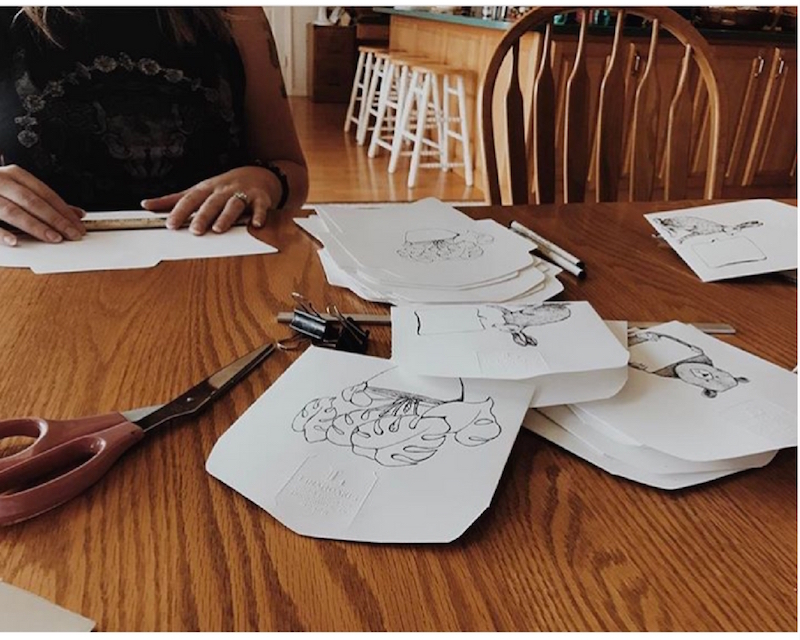 Above: a collection of envelopes using my designs by @sculptedfilms on Instagram
Above: a collection of envelopes using my designs by @sculptedfilms on Instagram
Can we all please just take a moment to appreciate all the lovely work that people all over the world are putting into these print-and-paint snail-mail templates?
I have put off writing this blog post because I didn't know quite how to express how happy it makes me, sending my mail designs into the world, and then seeing how people are using them and making them their own, in order to send creative mail to others. It still sounds trite when I put it like that, but it truly warms my heart to see people actually using and enjoying what I make... and knowing that they in turn are bringing joy to others through the post.
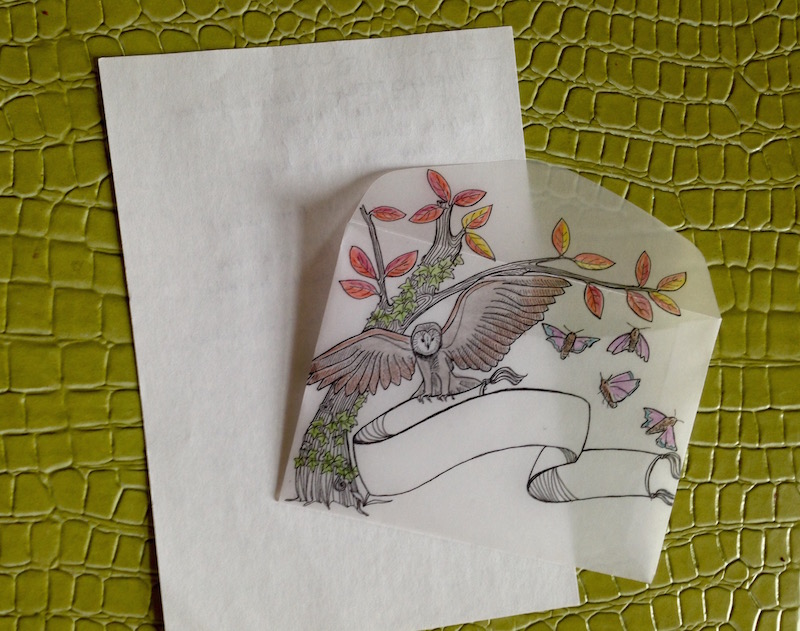
Above: transparent envelope by Snailmailcool on Facebook
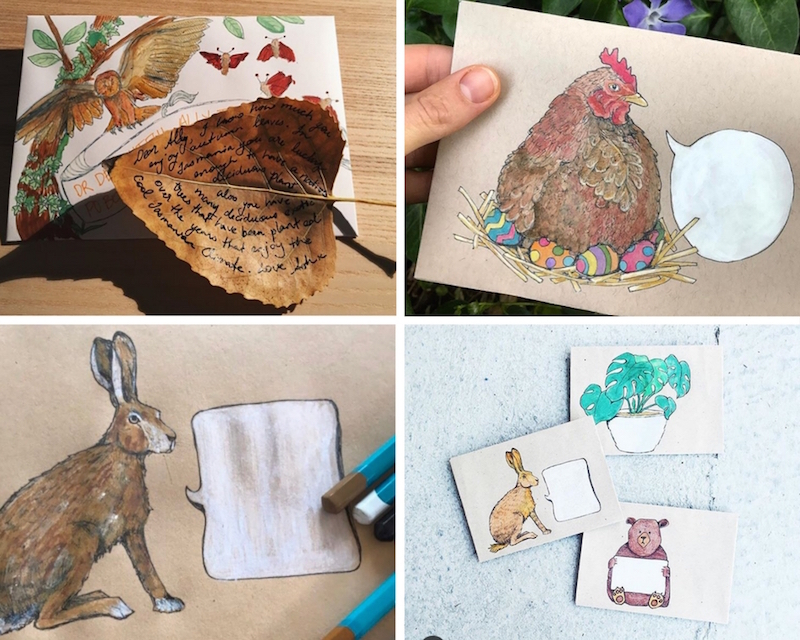
Above (clockwise from top-left): coloured envelopes by @murderingtime on Instagram, @lyndsey.thiessen on Instagram, @seniahhandmade on Instagram, @allyt_hobart on Instagram
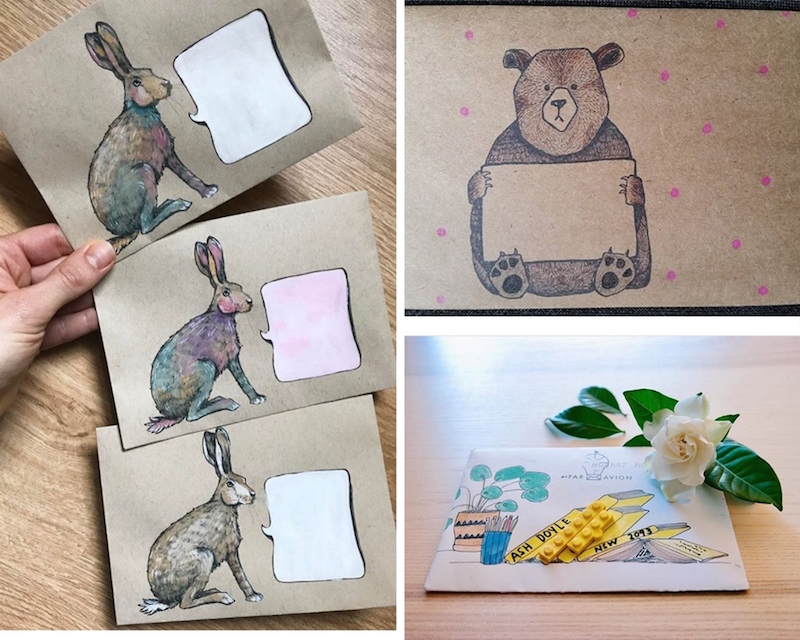
Above left, rainbow hare envelopes by @lyndsey.thiessen on Instagram, top right by @elisef03 on Instagram, bottom right by @allyt_hobart on Instagram
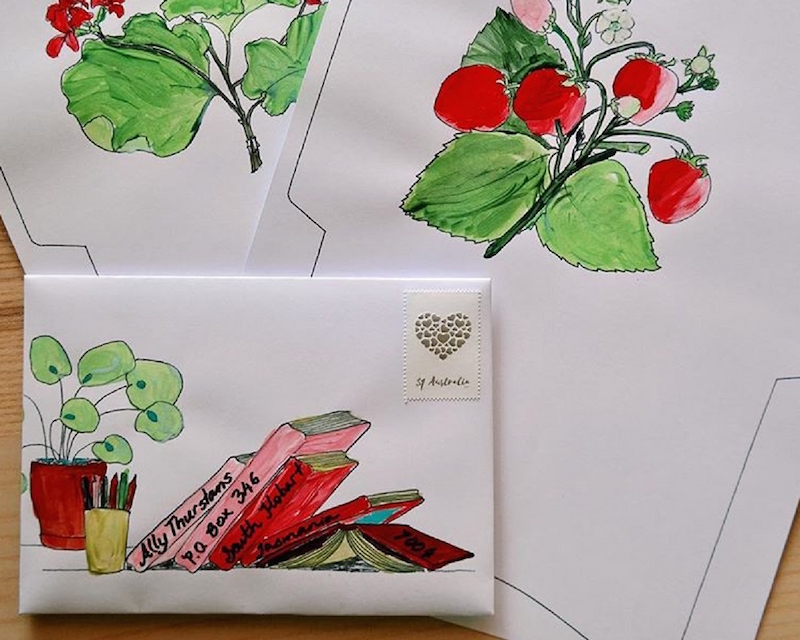
Above: strawberry, flower and book envelopes by @murderingtime on Instagram
If you don't know what this is all about, I create envelope templates with mail-art designs on them, that people can print off and turn into decorative envelopes to send through the post. They are free, and I send new designs out every month via my newsletter, Snail Mail Toolkit. You can sign up to receive them (as well as a free copy of my e-book, Making Mail: 10 steps to writing letters that become keepsakes, here.
Mail-art: into the forest
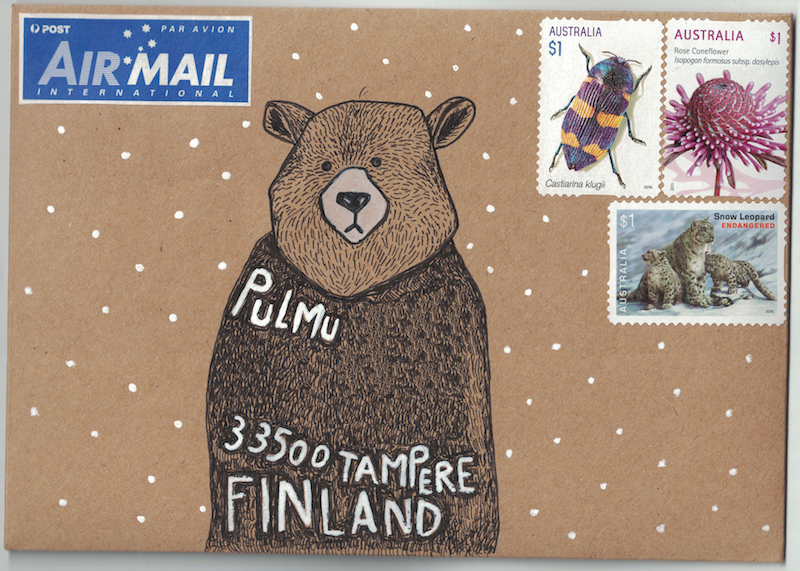 Recently I was commissioned to do a series of paintings of woodland animals, plants, trees and forest scenes. Inspired, I decided to play with the same theme in my mail-art, too.
Recently I was commissioned to do a series of paintings of woodland animals, plants, trees and forest scenes. Inspired, I decided to play with the same theme in my mail-art, too.
